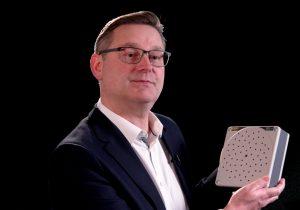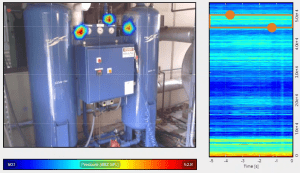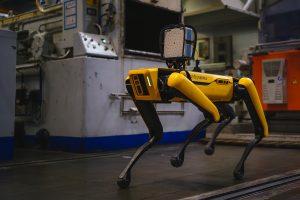Simon Powell
Fluke Process Instruments
 In this months home page interview Gord Montgomery of “The Monty Heat Treat News” speaks with Mr. Simon Powell, Business Unit Manager at Fluke Process Instruments. One of our topics of converstion is about a brand new Acoustic Imaging system just being introduced by the company. And what may you ask is an acoustic imaging system? Glad you asked. Turns out it converts sounds to images and its uses include being able to detect very small leaks in argon, air or nitrogen lines. Read on for all the details.
In this months home page interview Gord Montgomery of “The Monty Heat Treat News” speaks with Mr. Simon Powell, Business Unit Manager at Fluke Process Instruments. One of our topics of converstion is about a brand new Acoustic Imaging system just being introduced by the company. And what may you ask is an acoustic imaging system? Glad you asked. Turns out it converts sounds to images and its uses include being able to detect very small leaks in argon, air or nitrogen lines. Read on for all the details.
Today we have the privilege of speaking with Mr. Simon Powell, Business Unit Manager at Fluke Process Instruments (FPI). Simon, I understand that what you would most like to speak about today is a very interesting new product called the SV600. Before we get into it though I would like to pose a few questions to you about yourself, Fluke and Datapaq. Let’s start with yourself- how did you end up where you are today?
Sure, I joined Fluke Process Instruments 10 years ago as Marketing Director and have since enjoyed a few commercial roles including Customer Experience Director and more recently, Business Unit Leader for the Datapaq profiling business. (Your readers may be familiar with the Datapaq temperature measurement dataloggers). I am based in our UK office in Cambridge, where the core Datapaq engineering and product management teams are based.
Two years ago, I was asked to lead a small team focused on growth initiatives, launching our first product, the SV600, into the exciting new world of acoustic imaging technology!
When I think about FPI, I think about Datapaq, one of the best-known brands in the world when it comes to thermal profiling. However, I know that the Datapaq brand is just one part of what FPI has to offer. Can you tell us a bit about Fluke Process Instruments in general and the products you offer in particular?
Yes, Fluke Process Instruments is a worldwide leader in industrial temperature measurement solutions. FPI was originally made up of the three renowned brands of Raytek, Ircon and of course, Datapaq. Together, FPI became the temperature technology leader.
Our products offer top performing, rugged and dependable noncontact temperature measurement and profiling equipment – the portfolio includes a complete line of infrared sensors, line scanners, thermal imagers and profiling systems for use in today’s most demanding environments. FPI has been a pioneer of many industry firsts, market innovations and new technologies, and the brand of choice for the harshest, high-temperature industrial environments in manufacturing.
Now, we are proud to add acoustic imaging to that product stable!
The product you would like to introduce today is the SV600 Acoustic Imager. I tried to be well prepared for this discussion and did some research on Acoustic Imaging earlier this week, however I am still not entirely clear on the technology. Could you please explain in “layman’s” terms what acoustic imaging is?
Yes, I’ll try. As a non-engineer, explaining in layman’s terms is easier for me! Acoustic imaging is the use of ultrasound to produce real-time images of almost undetectable noise…to humans anyway. In other words, acoustic imaging allows us to see sounds. The units of frequency are called hertz (Hz). Humans with normal hearing can hear sounds between 20 Hz and 20,000 Hz (our ability to hear at this higher level unfortunately goes down as we get older). Frequencies above 20,000 Hz are known as ultrasound. When your dog tilts its head to listen to seemingly imaginary sounds, he or she is probably tuning in to ultrasonic frequencies, as high as 45,000 Hz. Many compressed air leaks in a factory cannot typically be heard by humans and are indeed ultrasonic, meaning above 20,000 Hz, and many can be up to 40,000 Hz.
Think of an acoustic imager as an array of sophisticated microphones which convert sound into an image. It relies on waves to produce pictures instead of vibrating sounds (the way your ear does) to show where seemingly undetectable sounds (and possibly air or gas leaks) might be. Once a technician can see an image of a sound/leak, he or she can go and repair it. We put together a great article on the history of acoustic imaging if you’d like to learn more.
Are you saying that from this “imaging” you are producing a picture showing where leaks are? Do you have an example?
 Yes, if a customer has a leak on a compressed air line or from a header valve, for instance, this leak will produce an ultrasonic sound which humans can’t hear but can be detected by the SV600. Acoustic imaging translates these sounds that it hears into a visual representation or map so problem areas can quickly be located. By integrating with factory systems, it can also serve as an early warning system to avoid equipment failure and will detect, locate and visualize air and gas leaks or sound signature changes. The SV600 also produces a precise acoustic image that visually displays ultrasonic information, even in loud, industrial environments. The acoustic image is overlaid in real time, allowing a technician to accurately pinpoint the source of the sound. It also allows for a more precise alert system, ending the toil of alert fatigue.
Yes, if a customer has a leak on a compressed air line or from a header valve, for instance, this leak will produce an ultrasonic sound which humans can’t hear but can be detected by the SV600. Acoustic imaging translates these sounds that it hears into a visual representation or map so problem areas can quickly be located. By integrating with factory systems, it can also serve as an early warning system to avoid equipment failure and will detect, locate and visualize air and gas leaks or sound signature changes. The SV600 also produces a precise acoustic image that visually displays ultrasonic information, even in loud, industrial environments. The acoustic image is overlaid in real time, allowing a technician to accurately pinpoint the source of the sound. It also allows for a more precise alert system, ending the toil of alert fatigue.
And what is the technology behind this? In other words, how do you produce an image?
The SV600 is a Fixed Acoustic Imager that uses an array of sophisticated sound sensors like microphones and powerful SoundMap™ technology to translate the sounds that it hears into a visual representation so that customers can quickly locate problem areas.
While the technology sounds very impressive the question on my lips and most of our readers would be: Where did this product come from and can you give us some examples of how this benefits heat treaters? For instance, can you track air leaks or is this for gases only?
Yes, Fluke is the pioneer of this technology for industrial applications and in 2019 the Fluke ii900 handheld industrial imager was launched. As with the ‘fixed’ SV600, the ii900 is similarly equipped with an array of microphones for an expanded field-of-view and enables users to quickly and accurately locate air, gas and vacuum leaks in compressed air systems. Fluke also developed SoundSight™ technology that powered the Fluke ii900, making it easy to learn and operate. The 7″ LCD touchscreen overlays a visual image for quick leak location identification. The ii900 has been a huge success with customer maintenance teams using the ii900 for detecting previously unseen air leaks and enabling quick fixes and savings in energy costs.
The SV600 can benefit heat treaters in several ways. The use case I would like to highlight first is based on a recent application need for the SV600, by the one of largest global heat treaters. This was at a site using Hot Isostatic Pressing (HIP) where the customer wanted to monitor dangerous argon/nitrogen gas leaks on the vessel, high pressure pipe work and infrastructure which, if inhaled, can be catastrophic.
Monitoring for gas leaks in the pit area under the furnace is usually done with static oxygen monitors and a manual measurement taken by an operator wearing PPE. However, installing the SV600 enabled a continuous 24/7 remote monitoring solution, which can detect leaks in real time and raise an early alarm before any risk in low oxygen levels occur. If the SV600 detects a gas leak and sets off an alarm the exact location and image of the leak can be recorded or sent to a control room, ensuring maintenance and repair is more timely and safer, thus limiting any possible furnace downtime.
In addition to HIP facilities, the SV600 enables critical equipment and associated compressors, pumps, valves, and pipes to be monitored for air or gas leaks in other heat treatment facilities. Not only can the SV600 detect air, gas or vacuum leaks, but it can detect unwanted electrical partial discharge, which may be relevant for facilities who need to monitor switchgear, transformers or electrical machinery.
Simon I would imagine that you are way ahead of me on this one-do you see this product as being used extensively because of safety issues? Specifically in cases where nitrogen or argon might be present?
Yes, as for the HIP example given in question 6, safety is a key driver for deploying the SV600. What we have seen across many of the industries we serve, that Maintenance Managers, Production Managers, and HSE Managers want SV600 to detect, locate and visualize air or gas leaks, or sound signature changes remotely without human intervention to create a safer work environment. We have seen many portable ii900 customers considering a fixed SV600 imager where they are concerned about sending people into unsafe areas where they need to continuously monitor for leaks or where they need to monitor an area or equipment at a distance or remotely.
Finally, and again from an HSE perspective, the SV600 includes user-programmable alarms for sound level (dB) and frequency (kHz) to help facilities better meet national and international standards and ensure workers are not exposed to dangerous noise and sound levels.
It’s a tired old cliché to say that the world is a more difficult place these days and that challenges abound on all sides, however that is the way many people feel currently. Having said that what challenges are you facing these days and how are you reacting to them?
As a manufacturer of electronic instruments, the biggest challenge is probably ensuring a reliable supply of the components we use. As part of one of the largest electronic test and measure companies, FPI has been able to keep supply chain disruption to a minimum by leveraging the Group’s extensive supplier base to secure the necessary parts.
Lets talk about trends. You see a lot of different companies in a lot of different geographic areas. Are you noticing any significant changes? Let me throw out an example; with the shortage of skilled people at least some companies are looking at taking some control away from operators and putting that control into the hands of controllers and automation-is this something you have seen? Any other interesting changes?
I think the example you mention is spot on. We are seeing one of the biggest challenges for our customers is a shortage of skilled labor which is increasing the need for more automation and digitization—whether that be for maintenance, production or quality teams. Through an Ethernet network communications interface (with installed 8-wire M12 fieldbus or RJ45 connector), the SV600 can integrate into the factory network / PLC. This really helps where customers have a need to improve automation.
The SV600 can have a big impact for manufacturers of products such as tanks, heat exchangers, radiators, etc. using traditional soapy water or water baths for their leak test process. The process can be automated with acoustic leak detection on the production line and immediately notify teams of quality issues or product rejects, thereby improving productivity.
 For larger facilities where labor shortages can have an even bigger impact, the SV600 can also be used as a payload for Boston Dynamics’ agile mobile robot, Spot®. Spot takes automated inspections to the next level by traversing large facilities or unstructured terrain to automate industrial inspections. It can monitor remote or difficult to access environments and provide situational awareness in remote settings. With the SV600 payload, Spot can be reconfigured to automate air and gas leak detection, increase maintenance team efficiency and greatly reduce safety risks and energy costs.
For larger facilities where labor shortages can have an even bigger impact, the SV600 can also be used as a payload for Boston Dynamics’ agile mobile robot, Spot®. Spot takes automated inspections to the next level by traversing large facilities or unstructured terrain to automate industrial inspections. It can monitor remote or difficult to access environments and provide situational awareness in remote settings. With the SV600 payload, Spot can be reconfigured to automate air and gas leak detection, increase maintenance team efficiency and greatly reduce safety risks and energy costs.
And how are we doing overall these days? Would you consider the heat treatment industry to be healthy and vibrant these days?
Generally, business is good. FPI has a broad range of products and while some markets and regions struggle, other regions and segments are growing. Europe, of course, remains challenging with energy costs rising and conflict in the region. This is offset by growth in demand for solutions in semiconductor manufacturing, in particular.
Recent FPI product launches have included some novel solutions for quench applications on the Datapaq heat treatment profiling side, and with vehicleweight reductions being a key driver for development (with electric vehicles in mind) this represents an opportunity for growth in the coming months.
Heat treatment in general has had a tough few years with COVID affecting the aerospace industry and the semiconductor supply chain hampering automotive production. That said, there are some signs of recovery with air travel increasing and new applications emerging as the electric vehicle market further develops. I think the future will be interesting, if a little hard to predict.
I very much appreciate your time and insights today Simon, thank you. Gord
Thank you, Gord, for giving me the chance to talk about this exciting new technology. We hope your readers find this of interest too. If they need more information on the SV600 visit https://www.flukeprocessinstruments.com/en-us/products/sv600-fixed-acoustic-imager or www.flukeprocessinsuruments.com, or email me at [email protected]
Did you like this article? Click here to subscribe to The Monty.
View our recent magazines and podcasts by clicking the following link. https://themonty.com/magazine/
